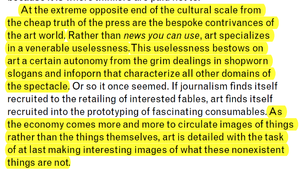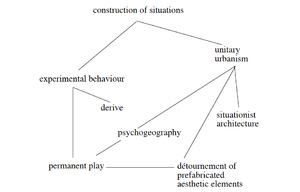SPECIAL ISSUE 14 MARTIN BOARD
FIGMA
REFERENCES
Web
containing:
- Pinball glossary
- Playing Skills
- Pinball apparition(s) in films / Pingeek
- Pinball apparition(s) in films / Tilt.it
- The Vandalist interface for the Situationist Times
Readings
- "Report on the Construction of Situations" by Guy Debord (Situationist International" chapter) [Readen]
- "Salvaging Situationism: Race and Space" by Andrea Gibbons [Readen]
- Contribution to a Situationist Definition of Play [Readen]
- "The détournement of détournement" by McKenzie Wark [Readen]
- "How to Read the Situationist Times" by Ellef Prestsæter [Readen]
- Racing the Beam The Atari Video Computer System (Platform Studies) Chapter 1 [Readen] Chapter 2 [To Read]
NOTES & IDEAS
PINBALL POSTER
As Pinball machines format is usualy rectangular and contains a rich combination of colors, typefaces, shapes and illustrations, we could see each pinball machine as a canvas, or a thematic graphic poster. It could be compared to the print format of a poster such as ISO format sA2, A1, A0 or 40 x 60.
The two links bellow contains posters made by the french studio 'Formes Vives' for the 2019 28th International posters competition of Chaumont festival.
http://www.centrenationaldugraphisme.fr/en/le-signe/collection/extra-ball
http://www.centrenationaldugraphisme.fr/en/le-signe/collection/golden-ball
see project description bellow (source):
Prix Espoir, 28th International posters competition, 2019.
These two works arose from an invitation by Ultra publishing house. The carte blanche was for the design of two posters to be displayed temporarily in backlit posterboards in the little town of Le Relecq-Kerhuon. The designers of Formes Vives plunged into a personal creation inspired by pop culture and the colourful exuberance of pinball flippers. All living in different cities, the three designers took pleasure in composing the images like a collage. This series was awarded the Prix Espoir of the International Poster Competition of the 2019 Biennale du design graphique in Chaumont.
PLAYER VS GRAVITY = FATALITY
Playing pinball seems to relate to an indivudual sport performance. The result of this performance is a score that can be compared to other players scores through a scoreboard visible on the alphanumeric display of the pinball machine . Even if it is possible for several people to be specators, there is usualy only one player. The inclinaison of the machine combined to the physical world gravity allow the player to play by himslef and try to push up the ball up again and again for the longest time as possible.
There is however something invetiable, or fatalistic about pinball, because as long as gravity exists, the ball will always go down. Then human failure or a lack of luck with unevitably cause the ball to go down and finally game over.
Note: read essay on the pinball machine (not found yet/ask Lidia)
VISUALLY OVERWELMED / EATER EGGS
Pinball Interface usualy is visually overwelmed by many colors text, illustrations, shapes, circuits and textures that can seem very complex to our eyes. This visual complexiy also allows its creator to hide many secret features and eastereggs that only an accident or many hours of game would allow us to discover.
PINBALL APPARITION IN VIDEO GAMES
Pinball game appearing in Sims1
https://www.youtube.com/watch?v=G0XrtcAjatQ
RANDOMLY GENERATED PINBALL GAME
From the glossary of pinball terms, if start considering each element of a pinball machine as a variant, it could be interesting to randomize pinball interfaces.
READING NOTES
Playing Pinball is delightfullllllll - Hans Brinkman File:SituationistTimes7.pdf
"You play not only against fellow players, but also against the mechanism."
The game of pinball: a psychological essay - Joost Mathijsen File:SituationistTimes7.pdf
"(…) the idea came to me that the game of pinball is about the systematic return of the balls. This games borrows its power from the longing to recover the discharged seed, from the fantasy of a double ejaculation: the spunk is hurled awat joyfully, achievs on player-ejaculator, ultimately returns to its point of departure. The pinball player bounces to expect the ball and to welcome it as a fullfilment of his sexual boomerang-illustion"
Something particularly pleasant - Léautaud File:SituationistTimes7.pdf
"The superficial pinball player lets out a shout of disappoitment, when his ball = spunk ultimately disappears again through the effect of gravity into its deeply hidden armoury. The complexity of this seeming disappointment is clear from the explanation given by a keen pinball player: “the ball cannot go into the hole”, whereby he forget that the whole game of pinball rests precisely on the fact that this disaster must happen sooner or later."
Report on the construction of situations / Toward a Situationist International - Guy Debord PDF
"(...)
the material environment of life and the behaviors which that environment gives
rise to and which radically transform it." (p.12)
Unitary urbanism is defined first of all as the use of all arts and techniques as means contributing to the composition of a unified milieu.
"The most elementary unit of unitary urbanism is not the house, but the architectural complex, which combines all the factors conditioning an ambience, or a series of clashing ambiences, on the scale of the constructed situation. Spatial"
"The
situationist game is distinguished from the classic notion of games by its radical negation of the
element of competition and of separation from everyday life."
"A rough experimentation toward a new mode of behavior has already been made with what
we have termed the dérive: the practice of a passional journey out of the ordinary through a
rapid changing of ambiences, as well as a means of psychogeographical study and of situationist
psychology."
"Everything leads us to believe that the essential elements of
our research lie in our hypothesis of the construction of situations."
"We must try to construct situations, that is to say,
collective ambiences, ensembles of impressions determining the quality of a moment. If we take
the simple example of a gathering of a group of individuals for a given time, it would be desirable,
while taking into account the knowledge and material means we have at our disposal, to study
what organization of the place, what selection of participants and what provocation of events
are suitable for producing the desired ambience."
"Situationist theory resolutely supports a noncontinuous conception of life. The notion of unity
must cease to be seen as applying to the whole of one’s life (where it serves as a reactionary
mystification based on the belief in an immortal soul and, in the final analysis, on the division of
labor); instead, it should apply to the construction of each particular moment of life through the
unitary use of situationist methods. In a classless society there will no longer be “painters,” but
only situationists who, among other things, sometimes paint."
"(...)the situationist attitude consists in going
with the flow of time."
"Your role is not to imitate the bourgeois aesthetes who
try to restrict people to what has already been done because what has already been done doesn’t
bother them. You know that creation is never pure. Your role is to find out what the international
avant-garde is doing, to take part in the critical development of its program, and to call for its
support."
50 Years of Recuperation of the Situationist International - Wark_McKenzie PDF
Salvaging Situationism Race and Space
"Situationists believe themselves capable, due to their current methods and to the foreseeable development of these methods, not only of rearranging the urban environment, but of changing it almost at will."
THE WORLD WE LIVE IN, and beginning with its material décor, is discovered to be narrower by the day. It stifles us. We yield profoundly to its influence; we react to it according to our instincts instead of according to our aspirations. In a word, this world governs our way of being, and it grinds us down. It is only from its rearrangement, or more precisely its sundering, that any possibility of organising a superior way of life will emerge.
"Psychogeography could offer the potential to broaden our theory and practice and collective reimagining, to see the city through other(s’) eyes, in an empathy that leads to action;to see collectively, past individual blindnesses, to name in full our oppressions, and overcome them. To overthrow capitalism. To create a new world. Because that’s the point, after all.
Let this practice be a real and effective tool of theory and revolution, not a glib way of imposing a narrow set of arcane interests and obsessions upon our cities that shuts out other voices, voices which speak and write words that cost them dear."
Contribution to a Situationist Definition of Play
"The new phase of affirmation of play seems to be characterized by the disappearance of any element of competition. The question of winning or losing, previously almost inseparable from ludic activity, appears linked to all other manifestations of the tension between individuals for the appropriation of goods."
"The element of competition must disappear in favor of a more authentically collective concept of play: the common creation of selected ludic ambiances."
"Due to its marginal existence in relation to the oppressive reality of work, play is often regarded as fictitious. But the work of the situationists is precisely the preparation of ludic possibilities to come."
Racing the Beam The Atari Video Computer System (Platform Studies) — Nick Montfort
Foreword
"We believe it is time for those of us in
the humanities to seriously consider the lowest level of computing systems
and to understand how these systems relate to culture and creativity"
1. Stella
"What does a creator, historian, researcher, student, or other user
do when experiencing a creative computer artifact? An encounter with
such a work could involve trying to understand the social and cultural
contexts in which it came to exist. It might also involve interpreting its
representational qualities—what it means and how it produces that
meaning. Alternatively, a study might involve looking at the methods of
this work’s construction, or the code itself, or even the hardware and
physical form of the machines on which it is used."
"Digital media researchers are starting to see that
code is a way to learn more about how computers are used in culture, but
there have been few attempts to go even deeper, to investigate the basic
hardware and software systems upon which programming takes place, the
ones that are the foundation for computational expression. This book
begins to do this—to develop a critical approach to computational
platforms.
We hope this will be one of several considerations of this low level of
digital media, part of a family of approaches called “platform studies.”
Studies in this fi eld will, we hope, investigate the relationships between
platforms—the hardware and software design of standardized computing
systems—and infl uential creative works that have been produced on those
platforms."
Types of Platforms
"To be used
by people and to take part in our culture directly, a platform must
take material form, as the Atari VCS certainly did. This can be done by
means of the chips, boards, peripherals, controllers, and other components
that make up the hardware of a physical computer system. The
platforms that are most clearly encapsulated are those that are sold as a
complete hardware system in a packaged form, ready to accept media such
as cartridges"
In drawing raster graphics, there is a considerable difference
between setting up one television scan line at a time as the Atari VCS
demands, having a buffered display with support for tiles and sprites, or
having some more elaborate system that includes a native 3D renderer.
Such a difference can end up being much more important than simple
statistics of screen resolution or color depth that are used as shorthand by
fans and marketers.
Cartridge Games for the Home
Pong’s start in a Silicon Valley tavern rather than a corner convenience
store or shopping mall is an important detail of the medium’s evolution.


